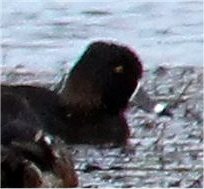 |
| Ring-necked duck with Shovelers and gadwall |
My main takeaway from the pandemic is that I'm not family-friendly.
It was a bright sunny morning in Manchester but dull and threatening rain by the time I stumbled off the train at Silverdale Station. Leighton Moss was reasonably quiet and most people were sensible and considerate.
Three skeins of pink-footed geese overhead as the train passed Barnacre was a good omen. As the train approached Silverdale a marsh harrier was busy spooking a flock of teal on the pool by the Eric Morecambe Hide and half a dozen little egrets worked around the edges of the islands.
 |
| Young male chaffinch |
I spent a few minutes checking out the feeders by the "Hideout." The chaffinches were busy chasing each other round the trees which gave a couple of goldfinches the chance to monopolise one of the peanut feeders. A marsh tit arrived almost immediately, I'd managed two of my target species with barely any effort.
 |
| Teal |
There was a queue for the Sky Tower so I went straight to Lilian's Hide. The reeds in front of the hide had been strimmed, providing a relatively dry spot for a few dozen teal to loaf around on while a male pheasant fossicked round for seeds. Out on the water were a few mallards and a couple of rafts of thirty-odd each of gadwall and shovelers. Half a dozen wigeon fed over on the far side of the water with a couple of drake pintails.
The path from the hide to the road was busy with chaffinches and house sparrows. Goldfinches bounced around high up, feeding on ash keys. Pairs of marsh tits and great tits fed on the seed someone had left on one of the gateposts.
A Cetti's warbler sang from the reeds by the boardwalk and a couple of others made sporadic bursts of song along the causeway. There were tantalising noises that might have been bearded tits but the wind rustling through the reeds made it impossible to be certain. Four skylarks flew over, heading North. A couple of finches flew high overhead, they sounded like lesser redpolls but I couldn't positively be sure, it's not a call I'm confident with. Approaching the Causeway Hide a couple of marsh harriers floated over and on over towards the Griesdale and Tim Jackson hides.
 |
| Gadwall, shoveler and, in front of the mute swan, ring-necked duck |
The Causeway Hide was reasonably quiet so I didn't feel selfish lingering awhile. Half a dozen cormorants loafed on the little island with a couple of shovelers. Out on the water there were a family of mute swans, a drake pintail swimming to and fro and, over on the other side to the hide, a large raft of gadwall and shovelers with half a dozen wigeon. A young male sparrowhawk, still more brown than blue, shot low over the ducks, none of which paid any attention to it.
 |
| Pintail |
As I watched the sparrowhawk I noticed a couple of pochards sleeping in the middle of the pack. Then I noticed another bird, the first tufted duck of the day. Except it wasn't. A bit too square in the body; the head a bit odd: a peak rather than a tuft; the underparts bright common gull grey with a bright white vertical stripe by the breast. A drake ring-necked duck! A shoveler barged into it and woke it up, and there was the clincher: a steel grey beak with a white base and ending with a broad white band and long black nail. Nice. I found out later it had been seen yesterday, too. I wonder if it's the same one that was at Pine Lake last week.
 |
| Ring-necked duck (cropped detail) |
 |
| Shoveler and ring-necked duck |
Leaving Leighton Moss I decided to get a bit more benefit from my old man's day explorer ticket by getting the Barrow train as far as Ulverston and catch the Manchester train back from there. The main reason was to see what might be about on the Kent and Leven estuaries. The tide was lowish by now so I wasn't expecting large numbers of waders but you never know what you may see. Leaving Arnside there were a couple of dozen black-headed gulls on the mud with half a dozen each of little egret and carrion crow on the salt marsh. A couple of hundred black-headed gulls were milling about the salt marsh approaching the Leven Estuary with thirty-odd jackdaws. Three greylag geese flew over but didn't land. There were a few more black-headed gulls on the estuary and a flock of two hundred or more shelduck on the mud by the bank on the Plumpton side.
I sat on the landward side of the train on the way back. Nine mute swans swam on the River Leven and three curlew fed on the mud in the creeks. Crossing the Kent there were eight mute cygnets, thirty-odd black-headed gulls and a handful of redshank.
The trains weren't right for a circuitous route home and I struck dead lucky with an unscheduled stop at my local station. Always quit while you're still winning.

No comments:
Post a Comment